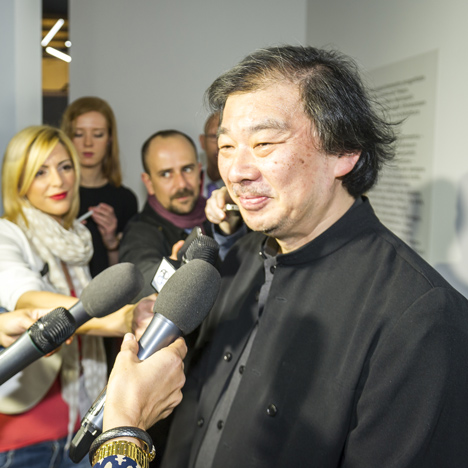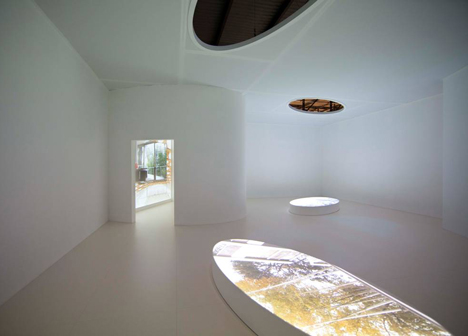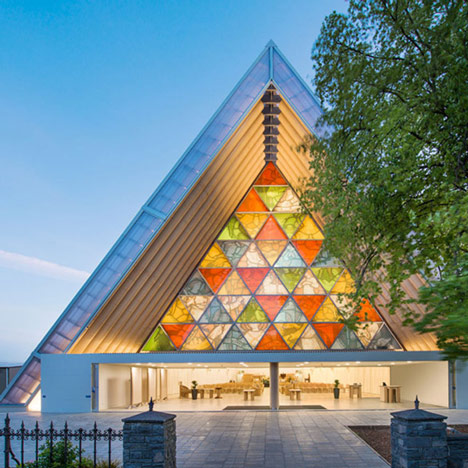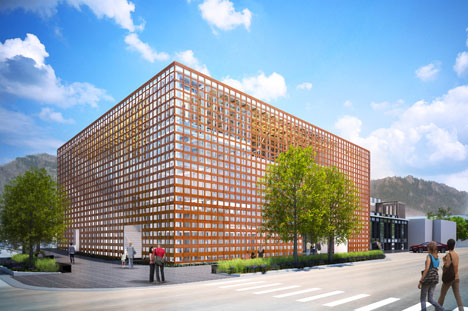
Architectural culture is "moving in two directions" says Shigeru Ban
News: young architects are becoming disillusioned with commercial work and instead turning to humanitarian projects, according to 2014 Pritzker Prize winner Shigeru Ban (+ interview).
Natural disasters such as the Japanese tsunami are "really changing" the way young architects think, Ban believes, encouraging them to use their skills for humanitarian causes.
"When I was a student everyone was working for big developers to make big buildings," Ban said. "And now there are many students and younger architects who are asking to join my team, to open programs in disaster areas."
He added: "It's really changing. I'm really encouraged."
Ban made the comments to journalists at the Salone del Mobile in Milan, where he was taking part in the Where Architects Live installation.

Architectural culture is "moving in two directions", he told Dezeen, as a new breed of younger architects turn away from urban work, where architects had ceded control to developers.
"Now cities are being made by developers, not architects, or not urban planners. They're made by developers. So one way is this but many people are interested in working for society also."
Ban is well known for his humanitarian work, creating temporary shelters from cardboard-based structures in disaster zones around the world.
His first paper-tube buildings were used to provide temporary homes for Vietnamese refugees after the Kobe earthquake in 1995. He has since created emergency shelters in India, Taiwan, Haiti and Japan as well as a cardboard cathedral for earthquake-hit Christchurch in New Zealand.

This work helped him secure the 2014 Pritzker Prize, which is widely regarded as the highest honour in world architecture.
Announcing the award last month, Pritzker Prize jury chairman Peter Palumbo said: "Shigeru Ban is a force of nature, which is entirely appropriate in the light of his voluntary work for the homeless and dispossessed in areas that have been devastated by natural disasters."
Ban has also realised a number of arts projects including the Centre Pompidou Metz in France and his Aspen Art Museum is due to complete this summer.

The Where Architects Live exhibition in Milan focuses features a series of installations based on the domestic environments of nine eminent designers, based in eight different cities, including Ban, Daniel Libeskind, Zaha Hadid and David Chipperfield.
Here's a transcript of the conversation between Ban, Dezeen and other journalists at the Salone del Mobile:
Journalist: Do you work a lot on projects for refugees?
Shigeru Ban: Yes with natural disasters. Yes almost every year some disaster. Now I'm working in the Philippines after the big typhoon there last year.
Journalist: What are you doing there?
Shigeru Ban: Building temporary housing there.
Journalist: What can you advise to young architects?
Shigeru Ban: You know, I really recognise when I give lectures to many different places in the countries, when I was a student everyone was working for big developers to make big buildings. And now there are many students and younger architects who are asking to join my team, to open programs in disaster areas, it's really changing. I'm really encouraged by all the young architects and students.
Marcus Fairs: Is that just in Japan that it's changing?
Shigeru Ban: No, no, no everywhere. Everywhere I got to give lectures many students are interested in what I'm doing and they want to join me and my team, it's really encouraging.
Marcus Fairs: So you think there's a shift in the world of architecture maybe?
Shigeru Ban: I think so, I really think so.
Marcus Fairs: Towards helping people more?
Shigeru Ban: Maybe not shifting but [moving in] two directions. Because now cities are being made by developers, not architects, or not urban planners. They're made by developers. So one way is this but many people are interested in working for society also.
Marcus Fairs: So there's new opportunities for architects to be more human, to be more helpful?
Shigeru Ban: Yes because unfortunately there are so many natural disasters destroying the housing, destroying the buildings so there are many opportunities for us.
Marcus Fairs: And in Japan did the tsunami change the attitudes?
Shigeru Ban: Yes, over 500km of coastline was totally damaged. Now the recovery is quite slow because they have to reclaim the land higher to prevent the next tsunami. So also changing of zoning to put residential areas on top of the mountains, so it's a very slow process. But it's the first time, even in Japan, that they're facing such a big problem.
Marcus Fairs: So are a lot of humanitarian architects working to solve the problem?
Shigeru Ban: Yes many architects are now working in that field, yes.